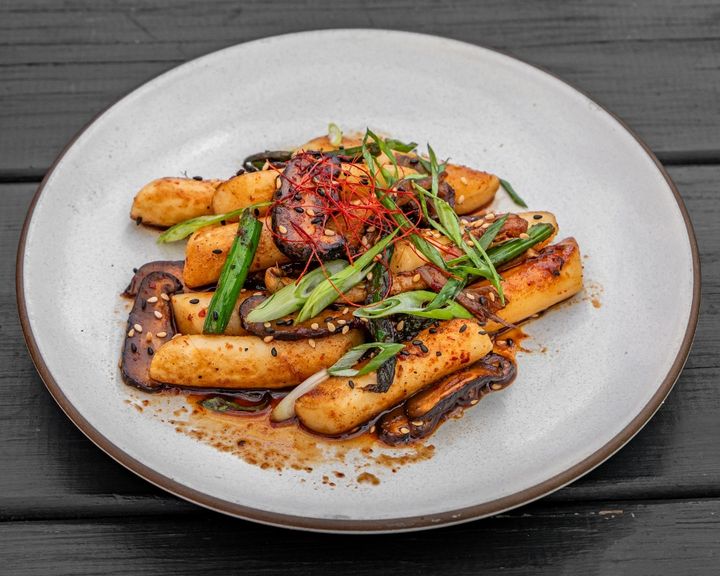Royale Style Tteokbokki at Miss Kim

A 500-year-old recipe for rice cakes wins over scores of fans
In recent years, Miss Kim’s reputation for culinary excellence has continued to grow in leaps and bounds—nearly every week, it seems another national article is singing the praises of chef and managing partner Ji Hye Kim. It’s not surprising, then, that more and more out-of-town guests are doing what they have long done at the Deli and Roadhouse: planning their Ann Arbor visits around food from Zingerman’s—Miss Kim has become a key component of their time in Tree Town. Many regular Mail Order customers from far-flung corners of the country (one guest told me his now-retired father on the East Coast orders from Mail Order every week!) have shared that over the course of a weekend, they come to town eager to experience what locals have access to all the time: sitting down at a table to eat full-flavored, traditional Zingerman’s food on site.
As in Korea, one of the most popular dishes at Miss Kim has been the spicy, pork-scented, gochujang-laced Street Style Tteokbokki. Its fame, both in Korea and in Kerrytown, is well-founded—it’s spicy and super delicious.
While the spicy Street Style gets a lot of attention, the much older recipe we make for the Tteokbokki Royale-style also has a lot of fans, me among them! It starts with the same “al dente” rice batons that we use for the Street Style Tteokbokki, but in place of pork and gochujang, this one is gently savory from soy sauce and sautéed shiitake mushrooms. Throw in some seasonal local vegetables to round out the flavor and texture, and you’re ready to eat. Exceptional umami and lovely, richly flavored vegan excellence.
The roots of the Royale Style Tteokbokki go back to the late 14th and early 15th centuries. It was, per the name, prepared to quell the hunger of the new king in the Joseon Dynasty. The Dynasty lasted an impressive five centuries—it fell only in the final years of the 19th century. As the Joseon dynasty began, and when this Royale Style Tteokbokki dish was developed, the chiles that make the Street Style Tteokbokki so terrific were still unknown on the Korean peninsula. They arrived only in the 17th century with Portuguese traders.
The Joseon period left a substantial legacy. Much of the modern Korean language and many of the still widely accepted applications of Korean cultural etiquette, norms, and societal attitudes were developed during the Joseon dynasty. The Joseon Dynasty finally came to an end in the 1890s, roughly 40 years after enslaved African Americans in the US and serfs in Russia had been legally freed. For those of us interested in the struggles we are experiencing here right now between autocratic and democratic constructs, about 15 years after the five centuries of Joseon rule ended, Korea became a conquered colony of Japan. Many attempts were made to free the country from within, but all failed until Japan was defeated by the Allies at the end of WWII. Even then, autocracy remained the order of the day until the spring of 1987, when mass demonstrations finally forced the dictators out and ushered in democracy—in what one might think of as something of a Korean corollary to Ukraine’s Revolution of Dignity in 2014.
Swing by soon to try this wonderful, umami-forward, terrifically flavorful vegan dish!
P.S. If you’re in Korea in the spring, there’s an annual Tteokbokki Festival in May. It draws about a quarter-million visitors!
P.P.S. Join Zingerman’s Food Tours in the Spring or Fall next year in South Korea! In this tour co-led by Chef Ji Hye Kim, we start with the old Seoul, visiting traditional food markets and street food stalls of Chef Ji Hye’s childhood and trying the dishes most representative of Korean cuisine—like tteokbokki and Korean barbecue. Then we go off the beaten path to explore the countryside to meet masters in gochujang sauces and kimchi, ceramics artisans, and the seafood foraging grandmothers of Jeju Island.



